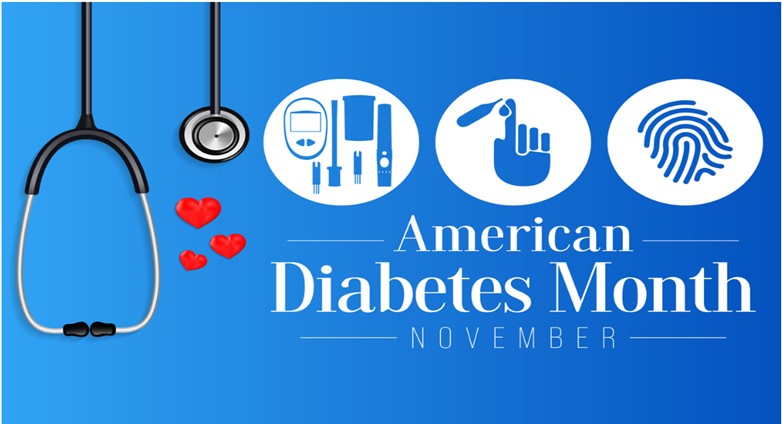
November is American Diabetes Month, a time dedicated to raising awareness about diabetes and those affected by it. While diabetes is a global concern, it’s particularly pressing in the U.S., where millions of people live with the condition.
The Centers for Disease Control and Prevention (CDC) estimates that over 10% of the U.S. population has diabetes. This means one in ten Americans is living with this condition.
Understanding Diabetes
Diabetes is a chronic condition in which the body either cannot produce enough insulin or cannot effectively use the insulin it does produce. Insulin is a hormone required for the body to turn sugar from food into energy. Without proper insulin action, sugar builds up in the blood, leading to a host of potential complications.
The Statistics: A Snapshot of the U.S. Epidemic
- Over 34 million people have diabetes (that’s about 1 in 10).
- Of these, 90-95% have Type 2 Diabetes.
- Approximately 1.5 million new cases are diagnosed every year.
- Diabetes remains the seventh leading cause of death.
There are two main types of Diabetes
- Type 1 Diabetes: An autoimmune condition where the body doesn’t produce insulin. It’s less common and typically diagnosed in childhood or adolescence.
- Type 2 Diabetes: More common and typically diagnosed in adults, this type arises when the body cannot properly use insulin.
Racial and Ethnic Disparities
Certain racial and ethnic groups, including African Americans, Hispanic/Latino Americans, Native Americans, and some Asian Americans, have a higher prevalence of diabetes, which underscores the need for targeted interventions.
Preventing and Managing Diabetes
- Awareness: Knowing your risk factors is the first step. Family history, age, obesity, and a sedentary lifestyle can increase one’s risk.
- Regular Check-ups: Yearly physicals and blood tests can help catch prediabetes or diabetes early.
- Healthy Lifestyle: A balanced diet and regular exercise can prevent or delay the onset of type 2 diabetes and help manage it.
- Medication: For some, medication or insulin therapy is essential. Always consult with a healthcare provider about the best treatment options.
Diabetes symptoms can vary depending on the type of diabetes – Type 1, Type 2, or gestational diabetes. However, there are common symptoms that may indicate the presence of the disease. Here is a list of symptoms that are commonly associated with diabetes:
- Frequent urination – When there is excess glucose in the blood, the kidneys react by flushing it out of the blood and into the urine, which lead to more frequent urination.
- Increased Thirst – The frequent urination that is necessary to remove excess sugar from the blood can result in the body losing additional water, leading to dehydration and a feeling of being more thirsty than usual.
- Extreme hunger – Despite eating, a person with diabetes may experience persistent hunger because the body’s cells are not receiving the glucose they need for energy.
- Unexplained weight loss – Particularly common with Type 1 diabetes, weight loss can occur even when one’s eating habits haven’t changed. This happens because the body is unable to get energy from glucose and starts burning muscle and fat for energy.
- Fatigue – When cells are deprived of glucose, it can lead to a feeling of being unusually tired or fatigued.
- Irritability and mood changes – These can occur due to the metabolic effects of diabetes on brain function.
- Blurred vision – High levels of glucose can lead to swelling in the lenses of the eyes, changing their shape and flexibility, and causing vision to become blurred.
- Slow healing sores or frequent infections – High blood sugar levels can impair the body’s natural healing process and its ability to fight infections.
- Tingling, numbness, or pain in the hands/feet (neuropathy) – Excess sugar in the blood can lead to nerve damage, which often presents as tingling or numbness in the extremities.
For women, there may be additional symptoms such as urinary tract infections, yeast infections, and dry, itchy skin. Gestational diabetes, which can develop during pregnancy, often does not have noticeable symptoms, and it is usually diagnosed through routine screening.
If you or someone you know is experiencing one of more of these symptoms, it is important to see a healthcare provider. They can provide a diagnosis and appropriate management of the condition. Early diagnosis and treatment can help to manage the symptoms of diabetes and reduce the risk of complications.
The Emotional Side of Diabetes
Living with diabetes isn’t just a physical challenge. The emotional and psychological aspects can be overwhelming. People with diabetes often juggle with:
- Managing blood sugar levels daily
- Fear of potential complications
- Financial burden of treatments
Supporting Those with Diabetes
- Education: Understand the basics of diabetes, so you can offer meaningful support.
- Empathy: Living with diabetes can be stressful. Be there to listen and understand.
- Encouragement: Celebrate the small victories, like maintaining a good blood sugar level or making a healthy meal choice.
Final Thoughts
American Diabetes Month serves as a reminder of the millions battling this condition daily. It’s a call to educate, understand, and support.
Whether you’re at risk, newly diagnosed, or know someone affected, there’s always more to learn and ways to make a difference. Together, we can work towards a healthier future, free from the constraints of diabetes.
